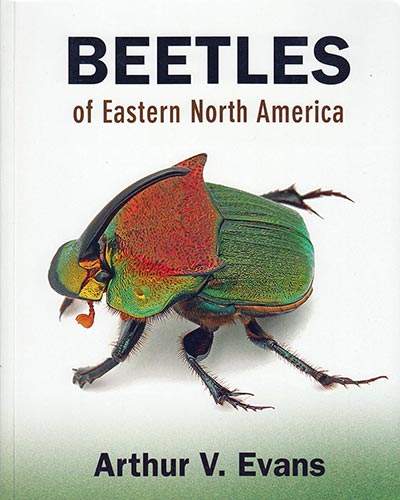by Arthur V. Evans
Princeton University Press, 2014
Thanks to the recent rapid compilation of insect photos at www.bugguide.com and other websites, identification of insects has never been easier. Art Evans has taken advantage of these resources and, working with these photographers and a number of beetle specialists, he has produced a well-edited book that provides a comprehensive treatment (560 pages) of the beetles of eastern North America.
The core of the book is the description of beetle families, where each family is introduced, characterized, and compared with other similar families, and their habitat/collecting techniques are discussed. Following this introduction, there are one to many photographs of commonly encountered species. This section of the book is particularly strong due to the excellent photos, which nicely combine the diversity within the family with the more commonly seen species in eastern North America. Associated with each photo is a paragraph discussing the biology, distribution, and distinguishing features of the species.
For those who already know a bit about beetles, this is a wonderful resource when you have a specimen or photo inhand, as you can look through the pages in a relevant section and quickly narrow the possibilities down to the likely family. If uncertain about a specific family placement, you can read through the notes describing families that are similar in appearance and see if you can find a better fit. If you are more of a beginner, there is a very nice introductory portion of the book where the commonly used anatomical terms are explained and well-illustrated, together with an extensive treatment of beetle biology, behavior, collecting and photographic techniques, and how to begin a collection. The key to families is short, emphasizing the more commonly encountered and easily recognized families, but associated with each of these keyed families is a list of other families that have a similar appearance, together with their relevant page numbers in the section on family treatments.
As Evans points out, in eastern North America there are 115 families of beetles holding around 15,000 species, and his book treats only 1,409 of them. Many beetle species are small and only a coleopterist will ever see or be able to identify them; understandably, there is no single resource that covers all of these species. This book does an admirable job of introducing beetles and their biologies at the level of family, and through the photographs treats many of the more distinctive genera while providing an opportunity to quickly identify many of the beetles that naturalists will encounter.
It is valuable to more experienced naturalists in that it also covers the families dominated by LBB’s (little brown beetles), that become more commonly encountered as interest in beetle diversity grows. This is a wonderful book for beginners working with insect biodiversity, for use in schools, and for naturalists. It is by far the most complete and useful book in providing an introduction to beetles and their biologies for eastern North America. The one disadvantage is that at 8x10 inches, it is too large to be used as a pocket field guide, though it will fit comfortably in a backpack.


